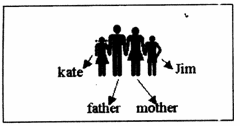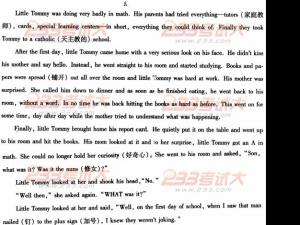Ⅲ.阅读理解
31.C [解析]根据文章第一段可以得出答案为C。
32.D[解析]由After the first day,little Tommy came home…didn’t kiss his mother and said hell0…was hard at work…without a word.可知答案应选D。
33.A[解析]根据Finally,little Tommy brought home his report card.He quietly put it on the table and went up to his room and hit the book.及他最后的数学成绩是A可知hit the books 的意思是“用功”。
34.B[解析]根据…on the first day of school,when I saw that man nailed(钉)to the plus sign(加号),I knew they weren’t joking.可知,Tommy是担心学习不用功会被钉在十字架上。B正确。
35.B [解析]Tommy把the man nailed to the plus sign误解为“学习不用功的惩罚”,从而努力学习,获得了好成绩。所以,误解有时也可以起到好的效果。
36.B [解析]这道题问他们为什么还住在山脚的破房子里。A项说他们想攒钱,文中没提到。B项说他们都很穷。第一段说因为他们从不动脑子,很贫穷,所以大家都住上了新房子但是他们还是在山脚住破房子,所以B是正确的。C项说因为他们的农场在山脚,但是其他的村民挣了钱之后都搬家住了新房子,所以这不是他们仍然住在这里的理由。D项说他们住的离农场不远,跟住破房子没有关系。所以答案选B;。
37.D[解析]A项说为了去旅行,B项说为了去看名胜古迹,C项说为了见朋友,D项说为了盈利。文中说Uncle Li去城里听说苹果卖得很贵,而且对话中也提到了盈利,说明目的是为了盈利而不是别的,所以答案选D。
38.C [解析]文中说他们犯苹果运到的时候已经有很多人早就把苹果运去卖了,所以他们的苹果卖不出去,只能低价卖。所以答案选C。
39.A[解析]文中说因为苹果卖不出去只能低价卖,所以亏本了,他们很不高兴。所以答案选A。
40.C [解析]A选项说这两个农民找到他们很穷的原因了。根据文章的意思,他们卖苹果亏本之后分析不到苹果卖不出去的真正原因是因为苹果太多供过于求,反而认为是苹果运的太少了,所以根本没有找到自己很穷的原因。B选项说这两个农民很快就会富有起表的,根据选项A的分析,B也不可能。(选项说两个农民都不聪明,根据选项A的分析知道C是对的。D选项说这两个农民打算买一辆卡车,文中没有提到。所以答案选C。
41.C[解析]根据第四段中的No matter what I did to the money,you still wanted it because it did not go down in value可知答案应为C。
42.D [解析]根据第五段中的you are always valuable to those people who love you可知正确答案为D。
43.D[解析]根据第五段中的Your value doesn’t come from what you do or whom you know,but WHO YOUARE.可知答案为D。
44.A[解析]根据学生三次回答老师问题的反应可知Hands went back into the air中的back有类似again的含义,故选A。
45.D[解析]通过文章内容很容易排除A、B、C项,所以答案选D最佳。
Ⅳ.翻译
46. It is our duty to keep our school yard clean and tidy.
47. She is now in trouble. I must help her.
48. Will you please call me as soon as you reach Guangzhou?
49. Mum often asks Dad to give up smoking.
50. I have made up my mind to be an actor.
V.教学设计
Teaching Plan: (one possible version)
Teaching methods :
利用课前准备好的全家放大照片让学生看,导出句型What’s this? It's a picture of my family.Can I see it? OK.然后让学生拿出自己准备好的全家照片进行演练。
利用准备好的Jim’s Family Tree图表投影片,边指图表边示范介绍表示家庭成员关系的生词:family,brother,sister,father,mother,son,daughter,mum,dad,grandfather,grandmother,parentes,wife,husband.并在此过程中介绍名词所有格,然后引导学生进行演练。
Teaching procedures :
1. Topic
(1) Who's on duty today?
(2) How are you?
(3) What's your name?
(4) How many people are there in your family?
(5) Who are they?
Teacher talks freely with some students.
2. Test(出示课件)
Answer the following questions.

Jim, Kate and their father and mother
Is this Jim? Who's this? Who's that? Who are they? Father and mother?
Teacher points to the picture and asks is students.
3. Presentation
Showing the picture: Jim's Family Tree
Points to the picture and says, "This is a family".
Asks: Whose family? Help students understand "Jim's family tree".
Teacher points to each person in the picture in turn and asks:
Who is this? (This is Jim Green.)
Who is she? (She is Kate Green. She is Jim's sister. )
Who is that man? (He is Jeff Green. He is Jim's father. )
Who is that woman? (She is Helen Green. She is Jim's mother. )
Who are Jeff and Helen? (They are Jim's parents.)
Who are Jean and Mary? (They are Jim's grandma and grandpa.)
Who is Jim? ("..." son.)
Who is Kate? ("..." daughter.)
Teacher may help students answer.
在学生回答的同时,教师教给学生图片中表示家庭成员的生词
4. Practice
Students look at "Jim's family tree"
Ask and answer in pairs.
让三名学生到前面,指图随意问班上的任何同学几个问题。(like the teacher)
Play the tape of part one for the students and let them read after the tape. Students read part one by themselves.
Note :
Possessives: HA:在名词后加" S"
Parent → father or mother
Parents → father and mother
Gets the students try to draw their own family trees.
Asks several students to introduce them.
5. Read
Students listen. Play the tape in the usual way. Give the students a chance to practise reading aloud as a large group and to their parents.
Then ask a few individuals to read aloud to the class.
6. Practice
Get the students to work in pairs to write questions about the reading in part two. One third of the class can write questions about the first part of the paragraph, another third about the middle and the last third about the end. After they have had a chance to prepare, get the students to read their questions aloud one by one. The rest of the class can give the answers.
7. Exercises in class
